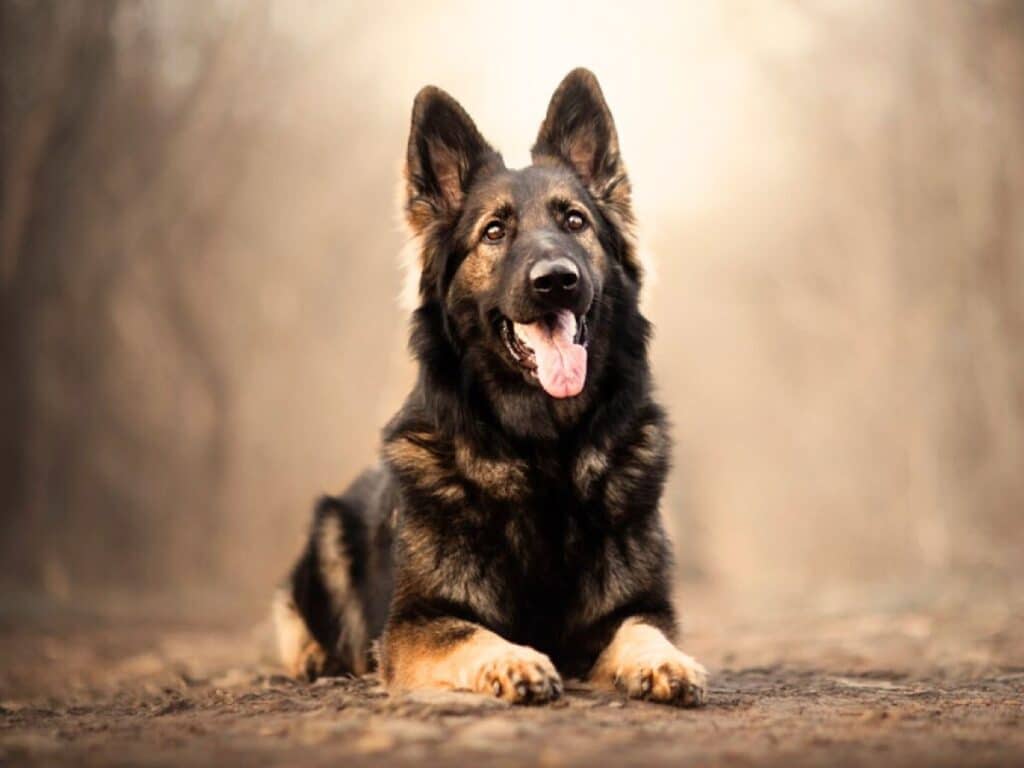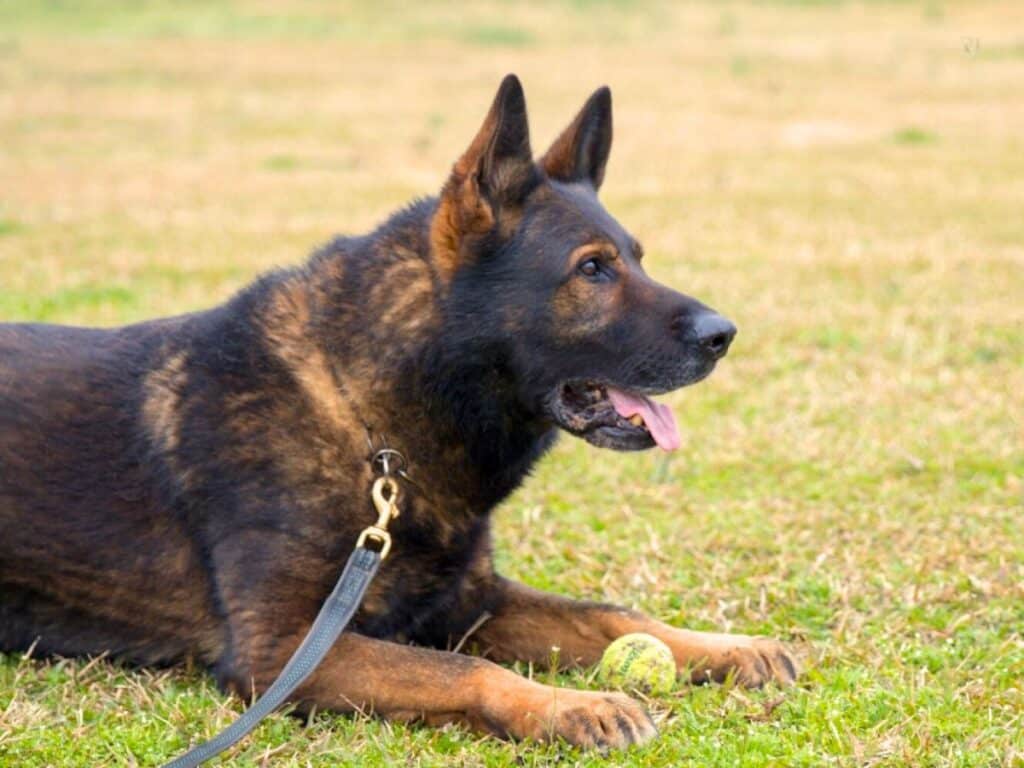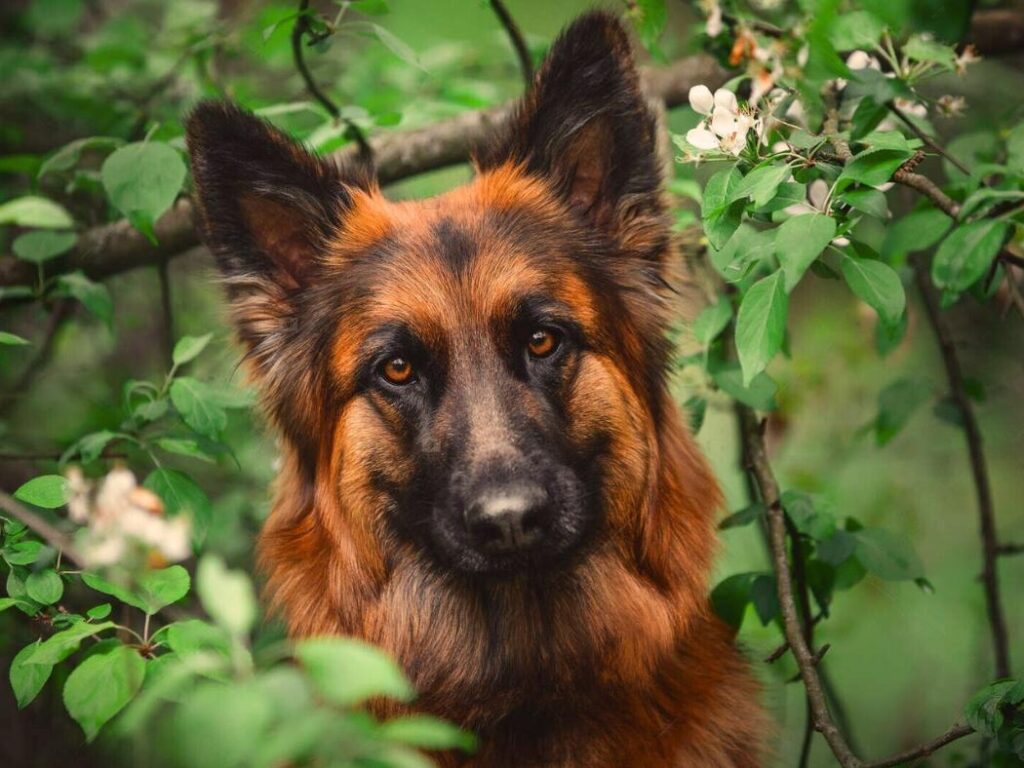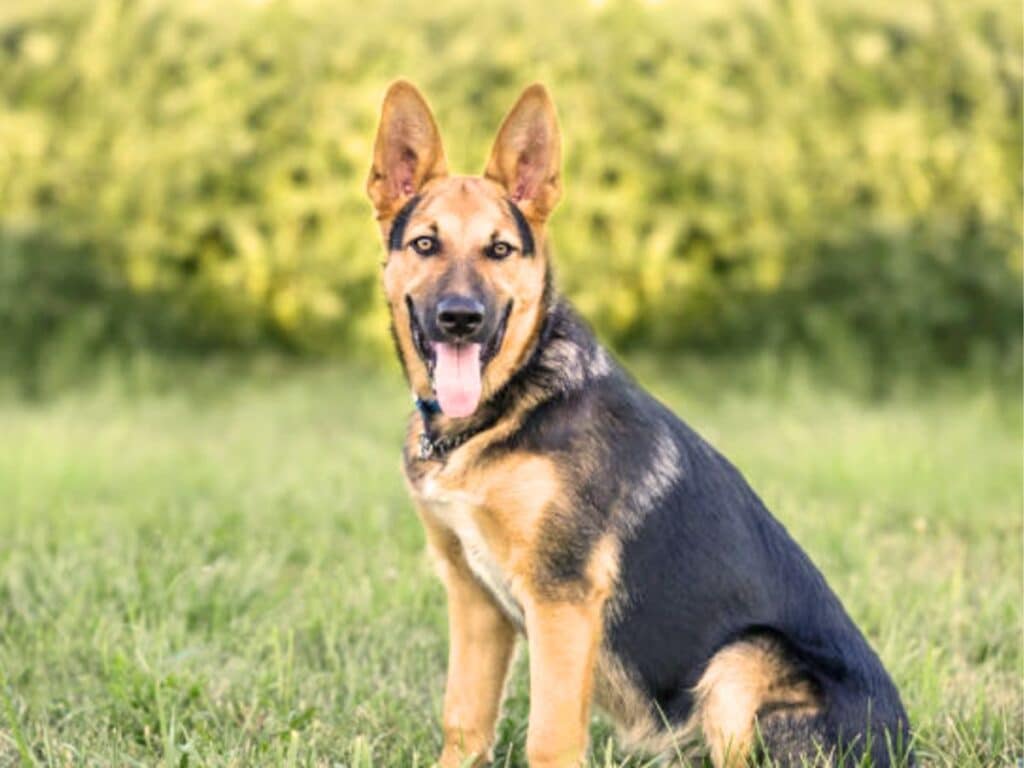DDR German Shepherds were bred in the former East Germany (which was then called Deutsches Demokratische Republik, hence the name DDR German Shepherd) for their exceptional working abilities. They were mostly used as attack, tracking, and guard dogs for patrolling the border between East & West Germany.
The DDR or East German Shepherds of today are a bit diluted versions of their predecessors as some of their aggression and working abilities have been bred away by modern breeders to make them suitable for families.
In this article, we will cover everything there is to know about DDR German Shepherds, from their history and origins to their behavior traits and cost.
So let’s dive in!
DDR German Shepherd: An Overview
In the table below, we delve into various aspects of DDR German Shepherds, from their size, temperament, and trainability to their historical significance and modern roles.
| Characteristic | DDR German Shepherd |
|---|---|
| Height | 24-26 inches (Males), 22-24 inches (Females) |
| Weight | 66-88 pounds (Males), 49-71 pounds (Females) |
| Cost | $1,000 to $3,500 |
| Temperament | Intelligent, loyal, courageous, and protective. Known for their strong work ethic and versatility in various tasks. |
| Trainability | High; DDR GSDs are known for their ease of training and ability to learn commands quickly. |
| Working Abilities | Excel in obedience, tracking, herding, protection work, and various dog sports. |
| Socialization | Early socialization is crucial to ensure a well-rounded and confident adult dog. They may be reserved with strangers. |
| Intelligence | Highly intelligent; they thrive on mental stimulation and problem-solving. |
| Exercise Needs | High; 1-2 hours of daily exercise and mental stimulation are essential. |
| Living Conditions | Well-suited for both suburban and rural environments, provided they receive enough mental and physical stimulation. |
| Guarding Instinct | Strong; natural protectors with a territorial nature. |
| Lifespan | Generally healthy, with a lifespan of around 10-13 years. |
| Historical Significance | Bred in East Germany for military, border patrol, and police work during the Cold War era. |
| Modern Role | While some continue to work in various roles, many DDR Shepherds are also kept as loyal family companions. |

What’s a DDR German Shepherd?
DDR German Shepherd is a line of German Shepherd breed that originated in East Germany during the Cold War. These dogs were strictly bred for their working abilities and were used by the military and border patrol units.
The criteria for breeding DDR German Shepherds included traits like strength, agility, and resistance to harsh weather conditions. This made them ideal for tracking and attacking the deserters who tried to flee to West Germany from the East.
Brief History of the DDR German Shepherds
The German Shepherd breed was developed in Germany in the late 19th century by an Army Captain named Max von Stephanitz.

DDR German Shepherds however originated in post-World War II Germany.

After the war, the Berlin Wall was built which divided Germany into West Germany and East Germany, also known as Deutsche Demokratische Republik (DDR).
The East German Communist Party took control of breeding the German Shepherd dogs and set up a strict breeding program.
The breeding program aimed to create a dog that was not only physically but also mentally superior to other breeds.
These dogs were bred to withstand extreme cold temperatures and trained to scale six-foot walls.
The breeders would check every litter for the right temperament, coat quality, ear set, bone structure, teeth, and overall appearance.
A DDR German Shepherd would be immediately removed from the breeding program if the dog was found to have a flaw, such as an unstable temperament, undesired bone structure, or hip dysplasia.
They wanted strong dogs with large heads, the kind of dogs that could be athletic, and agile with a powerful bite force.
The goal was to produce a dog that could serve as an ideal working companion for law enforcement agencies, such as the East German Border Police (Grenzschutz Polizei).

After the Fall of the Berlin Wall
After the fall of the Berlin Wall in 1989, many DDR GSDs were abandoned or euthanized due to the lack of resources available for their care.
However, some breed enthusiasts were able to rescue these dogs and give them to their friends and families where they could live out their lives as family pets. Some of these dogs were even brought to other Allied countries such as the UK and the USA.
Today, DDR GSDs remain a popular breed among dog lovers who appreciate their unique history and characteristics.
RELATED: DDR vs Czech vs West German Shepherd: Working Line Dogs

Physical Characteristics of DDR German Shepherds
East German Shepherds have unique physical features that set them apart from other breeds.
- They have a muscular build with broad shoulders, a deep chest, and powerful hindquarters.
- Their double coats are typically thick, and straight so that they can withstand harsh winters.
- DDR GSDs are mainly dark in color, either black sable or solid black. They can also be a mix of black and tan, with tan that can border on red.
- East German Shepherds possess an elongated head that gives them a robust appearance.
- Their paws too are wider and stronger which helps them scale walls and navigate rough terrain.
- They stand tall at about 22-26 inches at the shoulder level and weigh between 60-90 pounds depending on gender.
- They do not have a sloping back like their show-line counterparts, so they are less prone to hip and joint issues like hip& elbow dysplasia.
Apart from these common physical traits DDR German Shepherds also have strong teeth which help in their work as protection guard dogs.
These dogs are known to have a bite force of 230psi which is twice that of humans.
The DDR GSDs are more muscular and agile than other types of shepherds.
Check out this DDR German Shepherd breed survey system from Vonultimate Kennels.

DDR German Shepherd Temperament
One of the most notable traits of a true DDR bloodline is their calm and confident temperament.
These dogs are not easily rattled by loud noises or sudden movements.
DDR German Shepherds have a confident and assertive demeanor that is tempered by their affectionate nature towards their owners.
Their balanced temperament allows them to be gentle with their family and be fiercely protective at the same time.
They are wary of strangers, which makes them ideal guard dogs.
However, they can be trained to accept new people with proper socialization techniques.
They are known for their steady nerves, which makes them ideal for jobs that require focus and concentration, such as law enforcement or search and rescue.
Intelligence & High Trainability
DDR German Shepherds are also highly intelligent dogs. They have an innate ability to learn quickly and retain information.
Given their high level of intelligence and trainability, DDR German Shepherds excel in obedience training and performing complex tasks such as substance detection.
Another trait that sets a true DDR bloodline apart is their strong desire to please their owners.
These dogs thrive on positive reinforcement and love nothing more than making their owners happy.
This desire to please makes them easy to train, as they are eager to learn new things.

Do DDR German Shepherds Make Good Family Dogs?
Yes with proper socialization and training at a young age, DDR German Shepherds do make good family pets.
These dogs will not only be active, engaged playmates for your children but will also be their fierce protectors.
Since the German Shepherd breed was initially bred to herd and protect, it’s not uncommon for them to keep children away from perceived danger.
Although a DDR German Shepherd will go to great lengths to protect your family and children, this, of course, doesn’t mean you can leave an infant around your dog without supervision or training.
Your DDR GSD requires a good amount of training and proper socialization before you can feel comfortable leaving kids with him/her.
DDR German Shepherds thrive on human companionship and can suffer from separation anxiety if left alone for long periods. You should be prepared to spend time with your dog and not leave them isolated for extended periods.
Consistent Training and Socialization
To ensure that DDR German Shepherds develop a stable personality, consistent training, and socialization are essential.
Without proper training, these dogs can become anxious or aggressive, which can lead to behavioral problems down the line.
Positive reinforcement techniques work best. These dogs respond well to praise and treats when they exhibit desirable behaviors.
Consistency is also key – training should be done regularly so that the dog understands what is expected of them.
Socialization is crucial for DDR German Shepherds. These dogs need to be exposed to a wide range of people, animals, and environments from a young age.
This exposure will help them develop into well-rounded dogs that are comfortable in any situation.

Practical Uses of DDR German Shepherds
East German Shepherds are known for their exceptional physical capabilities and strong work drive.
They were bred for use in military, police, and border patrol work.
These dogs have a muscular build, powerful jaws, and high energy levels that make them well-suited for physically demanding tasks.
Their instincts to protect, herd, and detect substances make them ideal candidates for a range of professions, including law enforcement.
Additionally, they are efficient at tracking and apprehending suspects and are often trained to detect potentially dangerous substances like explosives or narcotics.
Their sturdy build allows them to carry equipment on long treks or when in the field.
DDR German Shepherds can provide excellent protection to livestock by keeping predators away.
This breed is known to be fiercely protective of their human families and can extend this protective instinct toward other animals.
One unique feature of DDR German Shepherds’ working abilities is their ability to handle harsh climates and terrains.
They are well adapted to extreme weather conditions owing to their origins in East Germany’s freezing territories.

Pros & Cons of East German Shepherd
Pros
- Working Abilities: DDR German Shepherds are known for their exceptional working abilities. They are highly effective in military and police work. (Source) They excel in tasks such as search and rescue, tracking, obedience, and protection work.
- Intelligence and Trainability: East German Shepherds are quick learners and can excel in various training activities, making them suitable for advanced obedience and agility training.
- Loyalty and Bonding: East GSDs are known for their strong loyalty and bonding with their owners. They form deep connections and are devoted to their families. They are often protective and make excellent guard dogs.
- Physical Strength and Stamina: DDR GSDs are bred for their physical strength and endurance. They possess robust muscular builds, allowing them to handle physically demanding tasks. They have the stamina to engage in long periods of activity and exercise.
- Health and Longevity: DDRs often have good overall health and longevity compared to some other lines of German Shepherds. This is due to the rigorous breeding standards set in place by the DDR breeding programs.
Cons
- High Energy and Exercise Needs: DDR German Shepherds are a high-energy breed and require regular exercise and mental stimulation. If their exercise needs are not met, they may become bored or exhibit destructive behavior.
- Strong Prey Drive: DDR GSDs have a strong prey drive, which means they may be prone to chasing smaller animals such as cats or squirrels. It’s important to provide proper socialization and training to manage this instinct.
- Protective Nature: While their protective nature can be a positive trait, it can also be a challenge if not properly channeled and managed. They may be suspicious of strangers and require early and ongoing socialization to prevent aggression or excessive guarding behavior.
- Size and Strength: They tend to be larger and more robust compared to some other lines of German Shepherds. While this can be advantageous in certain working roles, it may require additional training and handling for some owners who are not accustomed to larger dogs.

Check out this amazing video about DDR German Shepherds…
DDR German Shepherd Health Concerns
DDR German Shepherds have a lower incidence of hip dysplasia and many other health conditions compared to the other types of German Shepherds, as the breeding practices in East Germany were focused on eliminating the condition entirely.
The original breeders of the DDR bloodline implemented a zero-tolerance policy for hip dysplasia and other ailments among their stud dogs, resulting in a reduced genetic predisposition to the condition in these dogs.
Even though there are fewer instances of hip dysplasia and other joint issues, you will still need to be careful, anyway.
Keep in mind that some modern-day DDR GSDs may have been crossed with other lines of German Shepherds, it is reasonable to expect these dogs to have inherited some health issues from the other dogs.
Life expectancy
DDR German Shepherds have a longer-than-average life expectancy.
These dogs live for approximately 10-13 years with proper care and regular veterinary check-ups.
Age-related complications like arthritis, hip dysplasia, and degenerative myelopathy can affect their lifespan.
Owners must take care of their dog’s health by providing a healthy diet, regular exercise, and reducing environmental stress factors.
Regular vet visits are recommended to catch any age-related issues before they become serious health concerns.
RELATED: German Shepherd Life Expectancy: How Long Do They Live

DDR German Shepherd vs Czech German Shepherd
The DDR and Czechoslovakia, both members of the Soviet Bloc, developed working dogs for use as aids to border guards as well as for use as protection dogs.
Due to the close relationship between the two, Czech German Shepherds and East German DDR German Shepherds are essentially the same bloodline, yet there are a few differences.
Certainly! Here’s a table differentiating between DDR German Shepherds and Czech German Shepherds based on the provided information:
| Czech German Shepherds | DDR German Shepherds | |
|---|---|---|
| Origins and Breeding Goals | Originated in Czechoslovakia, bred for working abilities with a focus on military and police work. | Originated in East Germany (German Democratic Republic), bred for working qualities, commonly used in military, border patrol, and police work. Emphasis on endurance, intelligence, loyalty, and solid nerve. |
| Working Characteristics | Known for intense drive, high energy, and exceptional working abilities. Excel in tracking, scent work, search and rescue, and personal protection. | Characterized by solid nerve, strong defense drive, and high trainability. Versatile working dogs suitable for obedience, tracking, herding, and protection work. Known for stamina and endurance. |
| Temperament and Character | Intense and driven, high energy, natural protective instinct. More reactive and quick to respond to stimuli. Requires experienced handlers for effective management. | Known for loyalty, strong bonds with owners, stable temperaments. Balanced drive, generally calm and relaxed. Described as confident, dependable, and reliable. |
| Physical Appearance | More athletic and agile build, leaner body structure. Streamlined appearance with pronounced hindquarter angulation. Darker pigmentation and sharper features. | More substantial and robust build, straighter back, moderate hindquarter angulation. Traditional German Shepherd appearance, slightly lighter pigmentation. |

Frequently Asked Questions
How much does a DDR German Shepherd cost?
The cost of a DDR German Shepherd can vary depending on various factors such as the dog’s pedigree, lineage, age, training, and the reputation of the breeder.
On average, you can expect to pay between $1,000 to $3,500 for a DDR German Shepherd puppy from a reputable breeder.
However, it’s important to note that the price range can be influenced by market demand, geographical location, and the specific qualities of the individual dog.
Dogs with exceptional working bloodlines, strong working potential, and advanced training may be at the higher end of the price range.
At kraftwerkk9.com, working line GSD puppies are being sold at $6000-$7000 per pup.
It is highly recommended to do thorough research and find a reputable breeder who conducts health screenings, provides proper socialization, and has a good reputation in the German Shepherd community.
Are DDR German Shepherds Rare?
Yes, DDR German Shepherds are not as common as their counterparts from other breeding lines, especially those bred for conformation shows.
The breeding program that produced DDR German Shepherds was specific to East Germany during the Cold War era, and the reunification of Germany in 1990 led to changes in breeding practices.
While DDR German Shepherds are available with breeders, finding a purebred DDR German Shepherd with a documented lineage can be more challenging compared to other lines.
Many breeders have focused on different breeding goals, such as conformation, obedience, or agility, and may not prioritize the preservation of the specific traits associated with DDR working lines.
Enthusiasts who are interested in DDR German Shepherds may need to do thorough research and seek out breeders who specialize in preserving the working qualities of these dogs.
Conclusion: Is a DDR German Shepherd right for you?
When considering a pet, it’s essential to ensure compatibility with your lifestyle. A DDR German Shepherd is a highly trainable, loyal, and protective breed. However, their energy level and exercise needs require an active household. It’s crucial to consider your schedule and willingness to provide adequate exercise.
In addition, a DDR German Shepherd’s protective nature may make them wary of unfamiliar people and animals. Ensure you have the time and resources to socialize them properly. Overall, if you’re an active, responsible owner with the time and resources to dedicate to a DDR German Shepherd, they can make a devoted and loving companion.




